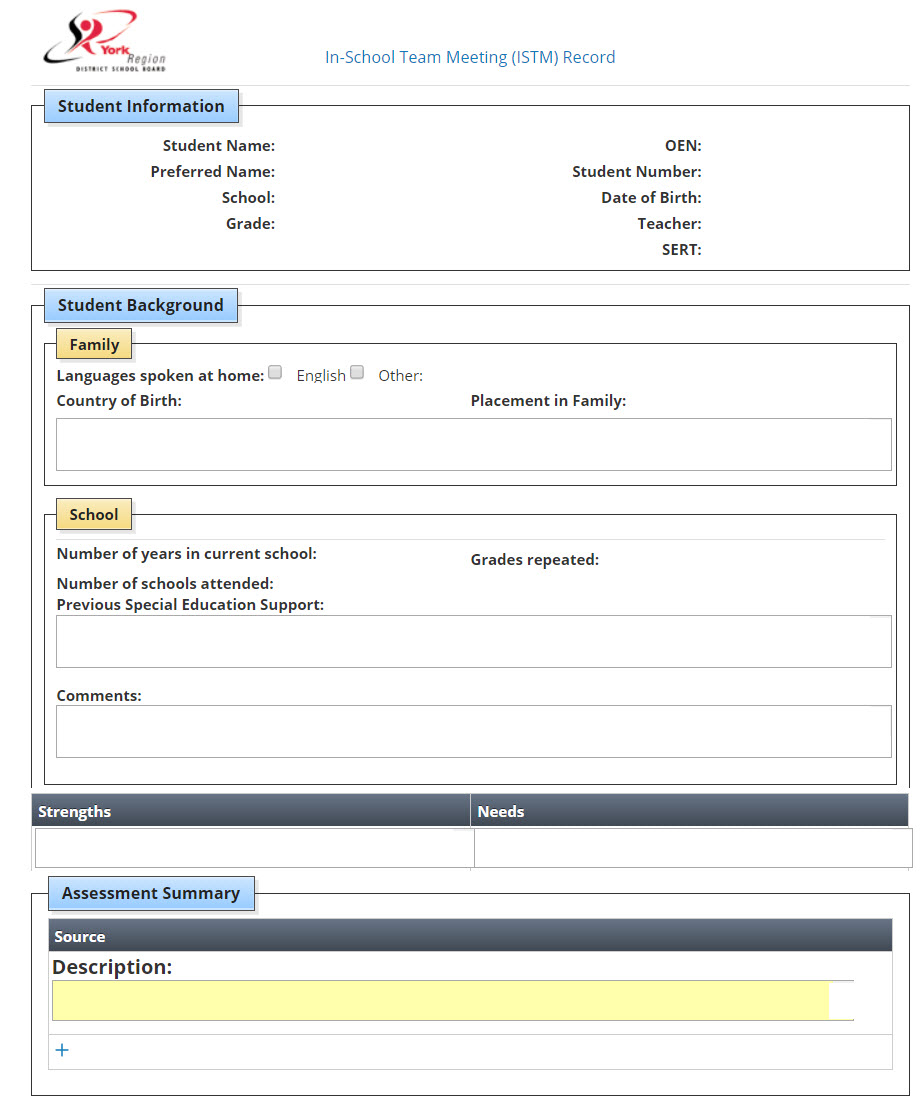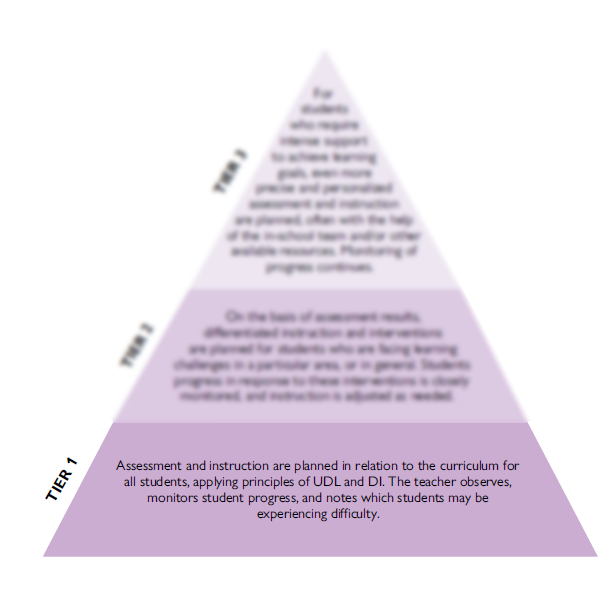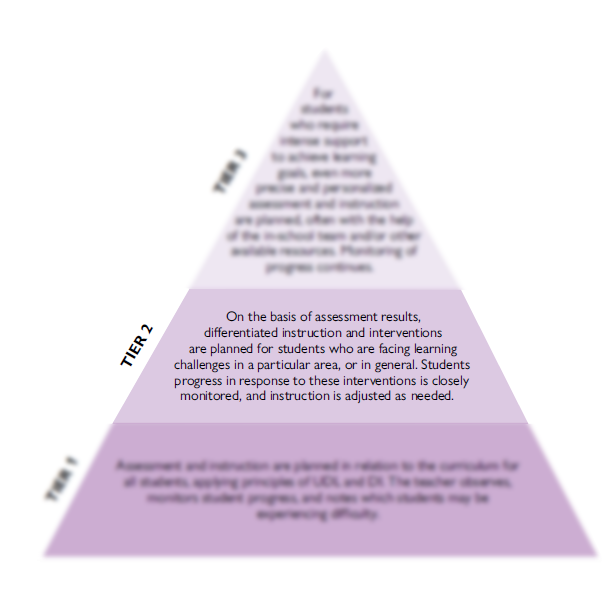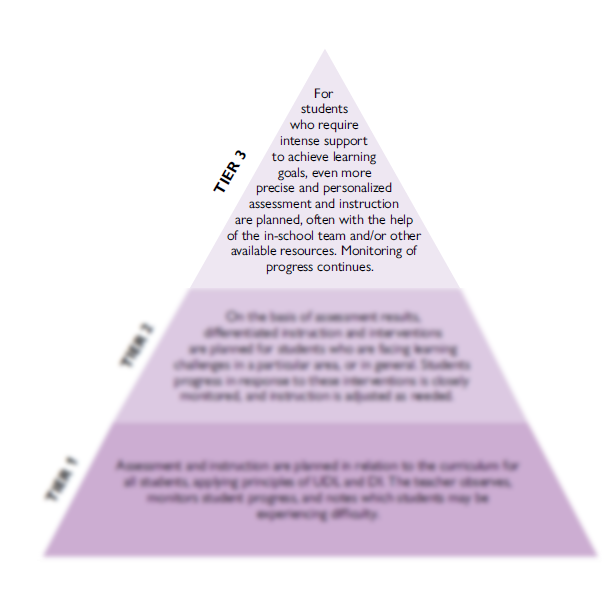The York Region District School Board endeavours to create learning environments that are inclusive of all learners. Planning, program development and service delivery processes have a strong tradition of including students with special education needs as an integral part of our culture. Through early identification of children’s learning needs, we can work together to raise the achievement and well-being of students who experience underservice and underperformance.
By closely monitoring the learning process for each student, the teacher is able to identify the instructional and assessment strategies necessary to support student success. The teacher can select a variety of strategies to support different learning styles, provide alternative approaches to learning, adjust pace or depth, or provide one-on-one or small group instruction. More specifically, the Learning for All K-12 document outlines a Student and Class Profile that facilitates the implementation of assessment based practices with universal design, differentiated instruction and the tiered approach to meet individual student’s strengths and needs.
In the YRDSB, the Understanding How Processing Affects Learning chart has been created to support staff in personalizing the instruction, assessment and environment for every student, using evidence-based strategies and interventions.
A teacher’s plan for intervention considers:
- lived experience & students’ intersecting identities;
- assessment for, as and of learning;
- student’s strengths, needs, abilities and interests;
- learning styles and preferences;
- the length of time needed for instruction, for practice, and for assessment;
- resources and alternate strategies to support learning;
- the tiered approach to determine when to access supportive strategies (see Understanding How Processing Affects Learning PDF);
- the roles that others can play to support the student’s learning needs; and
- community based resources and interventions.
In some instances, a student will require ongoing support in one or more subject areas. To ensure that this support is sustained, and that key learning needs are addressed, a Student Growth Plan is developed. The intent of the plan is to focus support according to individual student needs.
Where a student does not achieve the curriculum expectations in a course or subject the Principal and teaching staff, in consultation with the parents/guardians and the student, will determine what interventions or type of program would best enable the student to meet the expectations. When intensive intervention is required, students may be recommended to an In School Team. In this case, discussion will first focus on the results demonstrated as a result of the Student Growth Plan. Information will also be drawn from a variety of other sources.
Should further support be necessary, a follow-up In-School Team meeting should be organized, to support ongoing conversations with school based staff. Schools would follow a tiered approach to possibly access additional support from regulated health professionals, such as Speech Language Pathologists (S-LPs) and/or Occupational Therapists (OTs). Further conversations, following the tiered approach, may include involving members of the Interdisciplinary Team (IDT), through their referral process.
These procedures are a part of a continuous assessment and program planning process that should be initiated when a child is first enrolled in school or no later than the beginning of a program of studies immediately following Kindergarten and should continue throughout a child’s school life.
Parent(s)/guardian(s) as partners in their child’s education are invited to provide input, and share relevant documents to acknowledge their child’s strengths and needs through consultation and collaboration to ensure student achievement. .
The Special Education: A Communication Guide for Families and Students addresses questions that parent(s)/guardian(s) may have about their child's special education needs and where to go if they have a concern. It provides a list of parents/guardians guide resources, and contact information.
The Referral Process Policies and Procedures
Assessment, Referral, Identification and Program Planning
Regulation 181/98: Identification and Placement of Exceptional Pupils
Governs the identification and placement of exceptional pupils, Identification, Placement and Review Committee (IPRC) reviews, appeal procedures, and the role of parent(s)/guardian(s) in these processes.
In YRDSB Procedure #NP360.0 supports the administration of Identification, Placement and Review Committees.
Procedure #NP358.0 outlines the steps to be followed for the screening and identification of gifted students in the York Region District School Board.
Communicating with Parents/Guardians about Learning Challenges
As part of the Actions and Responsibilities in the Referral Plan, the teacher describes in-class program adjustments and encourages input, and the teacher consults with parent(s)/guardian(s) about the student’s progress and results of interventions.
View The Referral Processs: Actions and Responsibilities (PDF).

Referring a Student for an Assessment that may Lead to an IPRC
The practice in YRDSB is guided by the Referral Process, which is a collaborative process to plan and implement interventions to support students who may be in need of special education programs and services. This process begins with an In School Team Meeting, which includes an administrator, teacher(s), support staff, others (e.g., parent(s)/guardian(s), student). At this meeting, all relevant parties will review background information, discuss the student's current performance, review the effectiveness of classroom intervention(s) and outline the area(s) of concern. Staff involved will define the learning needs and if there is enough information then they should be able to brainstorm interventions, select interventions, plan implementation, plan monitoring and follow up times. If the implemented intervention is effective, further follow-up may not be needed. If the interventions are not effective, then the school support team will need to plan new interventions and/or gather further information.
If more information is needed, then the In-School Team will identify the information needed (possibly through assessment), identify personnel, and obtain parental/guardian permission, if required, for assessment. If an additional assessment is determined to be needed, then a follow-up In-School Team meeting will be held and this is where the team will review and synthesize data, recommend intervention or request an IPRC.
Referral to an IPRC is the last part of the referral process. Participants included are the administrator(s), parent(s)/guardian(s), student, teacher(s), support staff, and/or others. They review student information, determine the student's identification and placement, monitor progress, evaluate at regular intervals, adjust as appropriate, conduct an annual review and provide recommendations for next year.
The Referral Process: Actions and Responsibilities chart addresses the following actions: Classroom Interventions, In-School Team, and Referral to an IPRC and outlines the responsibilities of the Teacher, Special Education Resource Teacher (SERT), Administrator, Support Staff and Parent/Guardian Communication.
Notification that a Student is Being Considered for Referral to an IPRC
Principals are responsible for, within 15 days of receiving a written request for an IPRC, providing parent(s)/guardian(s) with written acknowledgement of receiving the request or notice of referral, a copy of A Parent/Guardian’s Guide to Identification, Placement and Review Committee (IPRC) and the approximate date of IPRC meeting. Principals should take into account previous In-School Team meetings where the Growth Plan, intervention strategies and progress were considered, ensuring that an educational assessment has been conducted. Principal are required to arrange the date, time and location of the meeting; invite the parent(s)/guardian(s) and/or student 16 or older in writing at least 10 days before the meeting using the Letter of Invitation, including the date, time and location of the meeting; consider inviting students under 16, where appropriate. As per Procedure #NP360.0, Special Education: Identification, Placement and Review Committee.
Notification that a Student is Being Considered for a Special Education Program and Related Services if Not Referred to an IPRC
If a student is being considered for a special education program and related services, this must be recorded in the In-School Team Meeting Record and a member of the In-School Team is responsible for following up with parent(s)/guardian(s) by a designated date.

Assessment Tools/Strategies to Gather Information to Assist in the Development of Appropriate Educational Programs
The YRDSB uses a variety of assessment tools to gather appropriate information on students in order to assist in the development of appropriate educational programs. Please see section 2.5 for a current list of assessment tools.
In alignment with Ministry of Education PPM 168, the YRDSB has implemented an early reading screening tool for students in year 2 kindergarten through grade 2.
The YRDSB also uses many different strategies to gather information on students to develop their program. Strengths and needs may be identified through the use of a variety of assessment tools and strategies. These tools include every day assessment strategies used by the classroom teacher to measure the progress students make with skill development and curriculum understanding. Examples of assessment strategies used daily are:
- asking questions that draw on the students’ experiences;
- having students think about how to use their knowledge;
- using observations, conversations about, and work samples of student learning;
- allowing student choice in how to show what they know;
- giving students assessments that use their strengths and support their needs;
- providing timely and meaningful feedback to students on their skill and knowledge development against the provincial standards.
Other classroom-based assessment tools may include: portfolios, diagnostic assessments and the use of the classroom profile which describes students’ interests and talents.
Additionally, classroom teachers with the assistance of the Special Education Resource Teacher (SERT) review student work, records and the students’ goals and expectations outlined in the IEP on an ongoing basis. Program goals and expectations are updated based on the student’s skill acquisition and demonstrated learning.
Early Intervention Strategies to Support Students Prior to Referral to an IRPC
Information Gathering
Information gathered through meetings with families and professionals, in and outside of the school board, is used by school staff to meet the needs of the student. The greatest number of students will be supported using the strategies in Tier 1. If students need more support, students, families and staff work together to move through the tiers of support.
Linking Assessment with the Tiered Approach:
The Tiered Approach is a model used as teachers plan to meet the needs of each learner in their class. The images beside each Tier below are from Learning for All.
Tier 1
Planning for instruction and assessment begins by knowing our learner. Information must be gathered around a student’s strengths, needs and interests to ensure we are addressing each student. Principles of Universal Design for Learning (UDL) and Differentiated Instruction (DI) will help guide the teaching learning cycle to ensure we address the learning needs of each student. As part of the planning process, a class profile can be used to better understand the strengths, needs and learning style of students in the class. The social, emotional and academic learning skills continuum will be considered as an essential underlying component of academic success.
For more detailed information about the classroom profile and individual student profile, please refer to the Learning for All document.

Tier 2
As the teacher observes, differentiates, and uses assessment strategies throughout instruction, there will be some students who will require planned interventions based on the analysis of student achievement. A growth plan is developed and results are monitored. The teacher may wish to develop a Student Profile to further develop an understanding of the student’s areas of strength and need. Teachers will use the classroom data and curriculum based assessment along with the growth plan to support the discussion at the In-School Team. The school team including the teacher(s), parent(s)/guardian(s), school support staff and administrator will collaborate to plan, monitor and determine the duration of strategies, resources and/or interventions. An outcome of the growth plan may be to adjust the interventions, which could include an additional In-School Team meeting.

Tier 3
A smaller percentage of students will require more intensive support and services. The school should consider using an interdisciplinary team approach to address more intensive student needs (i.e., learning, behaviour and/or social emotional needs). Student Services staff will be invited to the interdisciplinary In-School Team meeting based on the areas of concern, which may include:
- Vision
- Hearing
- Listening
- Oral Language
- Motor Skills
- Behavioural/Social Skills
- Attention/Concentration
Students are supported using early intervention strategies such as the tiered approach prior to an IPRC.
